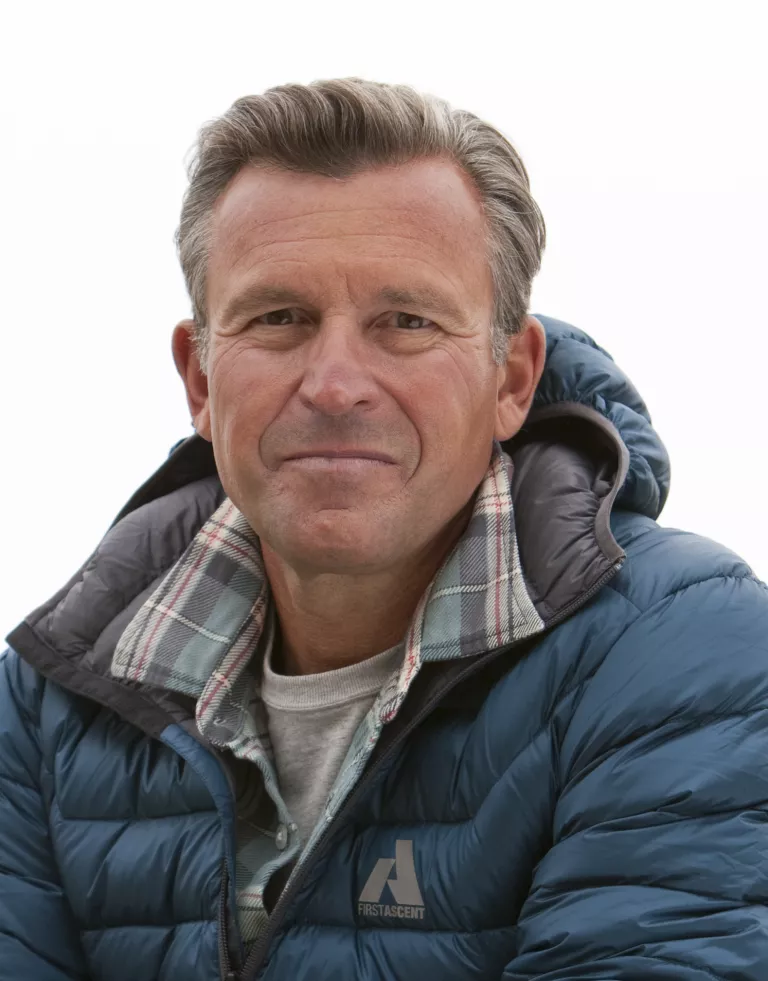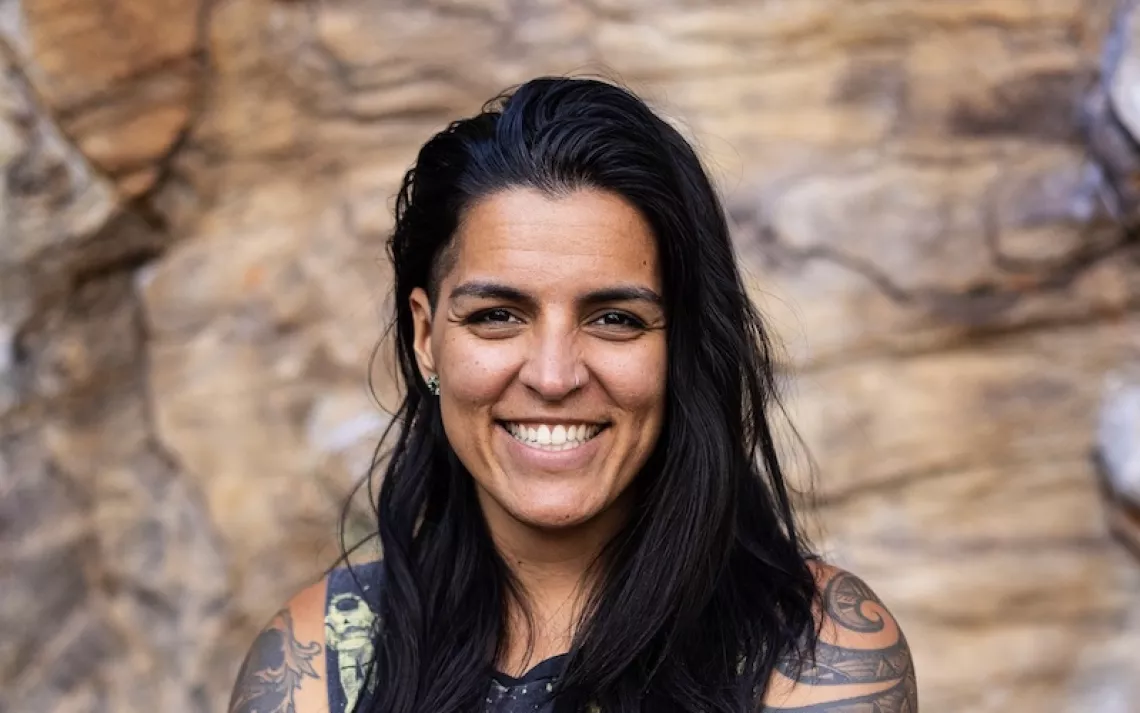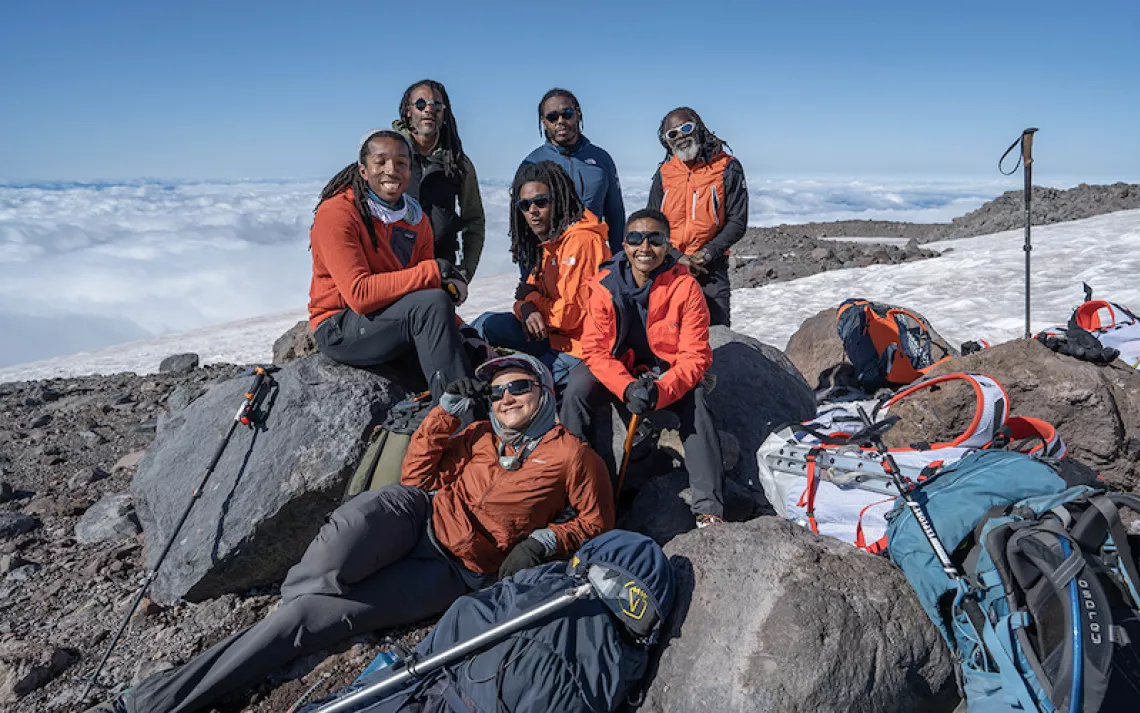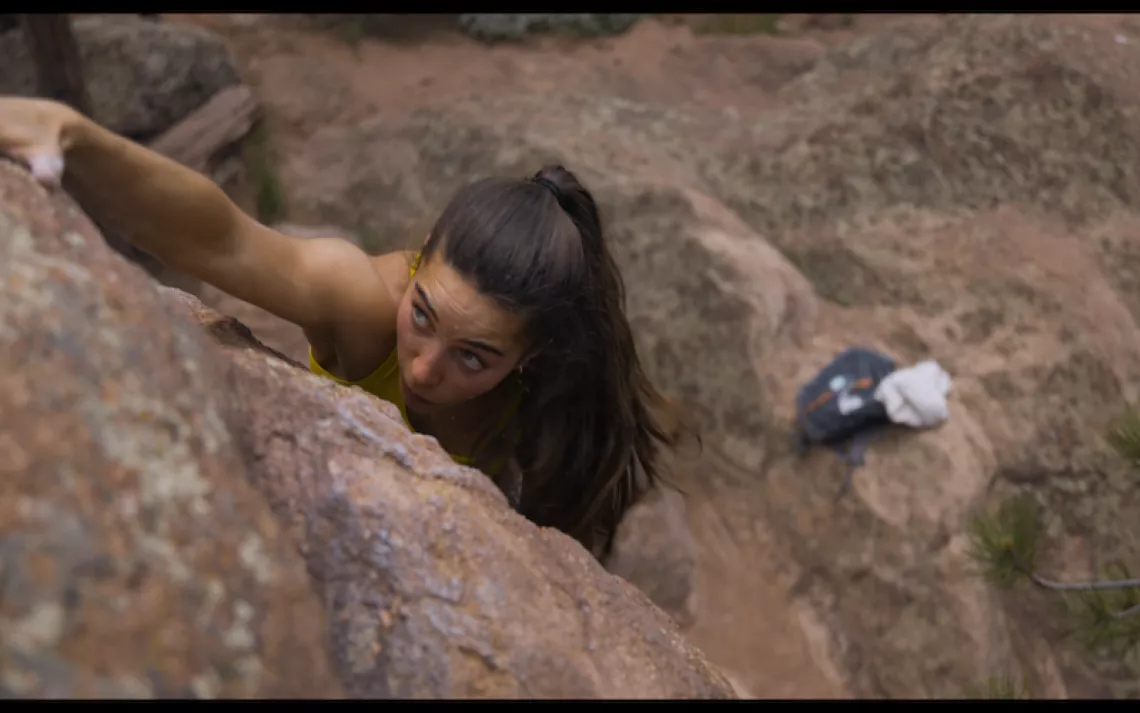Ed Viesturs Compares the World's Toughest Peaks

Photo by Eddie Bauer/Kyle Deleu
Hands down the greatest American mountaineer of all time, Ed Viesturs has set an unwavering example for climbing success. Along with a lifetime of achievements that include bagging all fourteen 8,000-meter peaks without supplemental oxygen, Viesturs is known for his unparalleled leadership and countless acts of high-altitude heroism, which define him as a mountain among men.
This world-class climber and influence to mountaineering guides around the globe is also a best-selling author of four books. His most recent, The Mountain: My Time on Everest (Touchstone, October 2013), is a collection of never-before-told accounts of his trials on Everest, and perhaps a way of saying goodbye to a mountain he successfully summited seven times.
We spoke with Viesturs about the most crucial part of an ascent, a serendipitous meeting at the top of Everest, his onetime resemblance to Alfred E. Newman, and which mountain was his toughest climb.
What do people misunderstand most in terms of climbing Everest?
I think today the misunderstanding is that anybody and everybody can climb the mountain. That for a certain amount of money, somebody will take you to Everest, and whether they're going to carry you or pull you or drag you, somehow money will get you to the top. Everest is not easier today than it was in 1953. It's not lower.
In 2005 you were questioning whether you would ever climb another 8,000-meter peak. But four years later, in 2009, you were back on Everest.
Yeah, I wasn't planning on going back to Everest. I was working for Eddie Bauer at the time, and they were thinking, "Hey, you guys have built this [First Ascent] product line, and the perfect coming-out party would be to have you guys go to Everest."
But you're renowned for knowing when to hold 'em and when to fold 'em. What made you decide to climb Everest one last time?
I was really kind of on the fringe. I hadn't said yes and I hadn't said no. I was thinking, "Is this worth going back to Everest again?" And ultimately, I decided it was. I was helping to launch a product line that I was part of. And I chatted a long time with my wife about it, and she finally said yeah, it is a reasonable reason to go. I felt comfortable with going back, knowing that it was going to be my last trip and I'd get to absorb everything and remember it.
You say in your book that "an ascent doesn't really count unless you come back alive." Does George Mallory's ill-fated summit of Everest come to mind?
It just seemed logical to me. Edmund Hillary was asked about Mallory as well, and he said [something like], "You know what, I think the coming-down part is also rather important." And I totally agree with that. Anybody could do whatever they could to climb to the top of that mountain, on death's doorstep. It doesn't show anything as far as planning or endurance if you can't get back down. A one-way trip doesn't count. The U.S. sent astronauts to the moon — the plan was to make sure they got back. When you get home, the first thing people ask you is, "How was the climb?" They never ask you, "How was the descent?" In actuality, that's the hardest part of the climb. They're tired, they're stumbling, they're barely able to get back to camp in some cases.
A huge percentage of climbing accidents happen on the descent, right?
Yeah, and if you barely make it down, you're not going to tell people, "Whew! I almost died on the way down!"
Who is your biggest mountaineering influence?
[Reinhold] Messner for sure. Especially his style, his forward-thinking. He was the first to say, "Let's try to climb Everest without oxygen." He was the first to do all 14 of the 8,000-meter peaks—the same path that I followed. Another guy I admire is John Roskelley. If he went on an expedition and thought the climb was too dangerous, he would tell the team, "Listen, I can't do this. I'm not going up." He didn't get swept up into what we call the "group think," and I totally admire that about him. And that gave me my convictions to not be afraid of turning around when others were going up.
It seems that kind of mentality saved you and your team from calamity high up on Everest back in in 1996, when 8 eight people died in a blizzard near the South Col. Did your mistrust of the "group think" come into play then?
Our group was scheduled [to summit] a day ahead of [climbing groups led by Rob Hall and Scott Fischer]. The weather patterns we were seeing indicated that the calm period we normally experience in May hadn't yet arrived. [The weather] wasn't terrible but it wasn't good. And we said that for the sake of the film [the Imax documentary Everest], we needed perfect weather. So we decided we'd go down, and then the next day all the others went up. And we didn't know—we couldn't have predicted the storm. Nobody knew what was coming. They were up there so long, and so high, and then the storm came. Had they turned around earlier, had they climbed faster, they might have snuck away before the storm hit.
Everest has been so frequently climbed, commercialized, and, some would even say, turned into a circus. Is Everest worth it anymore for a serious climber?
Thankfully, I was able to go in the late 1980s and early '90s, when the mountain was very quiet, relative to what it is today. But as a serious mountaineer today, you've got to realize that there's just going to be a lot of people there. There's no way to say, "I get to be here, and these people shouldn't be here." That's not fair either. You can go to other sides of the mountain. You can find quieter corners of Everest. And if you don't want to go to Everest, then, well, go somewhere else.
In your book you describe the chance encounter of meeting your long-lost friend Andy on one of your first summits of Everest.
It was incredibly rare—especially assuming that you're going to be on a peak alone—that one of your best friends, one that you haven't seen for a few years, who happens to be climbing up on the [Tibetan] side of the mountain, and at the same moment, at the same place, you bump into each other on top of the world. Like a one in a bazillion chance.
And what happened after? Did you two meet up for beers later?
No, I called him. He was on the Tibetan side and I was on the Nepal side, so we didn't see each other [at basecamp]. But when I got home, we certainly called each other and said, "Hey! Wasn't that a fun day?" We were up on the summit of Everest, and the weather wasn't that great, and we couldn't stay up there that long. We just said, "Hey, this is a hilarious moment," and then went our separate ways.
What's the first thing mountaineers usually do after a monumental climb like Everest?
When you get to Everest basecamp, that's when the initial celebration occurs. That's when you're surrounded by your teammates. We'll send a porter down to one of the villages and have him haul up a basket full of beer. I mean, you have to celebrate with them right then and there. You're just on this high. I mean, me especially, when I'm walking out from a climb that was successful, I'm like, "Wow, I just went on an amazing journey. All that time and energy I put into this was worth it. I feel really good about myself, accomplished what I set out to do." And then you just let yourself relax for however long it takes, soaking it in. For me, I always start thinking about what's next. Especially when I was doing all the 8,000-meter peaks. I immediately started making plans for next year.
When did you first feel the yearning to climb mountains?
It was when I read Annapurna [by Maurice Herzog]. At the time, when I was in high school, I liked things that were very competitive. I was a competitive swimmer, and I knew that by working hard I could achieve great things. We killed ourselves at swim practice, so I was used to the mental part of that and the physical part. So when I read about mountain climbing, I thought, "What a perfect physical outlet for me." Not that I could do it in Illinois.
The first peak you climbed wasn't in Illinois?
The first peak that I climbed was Mount St. Helens, before it blew up. This was 1977. I was 17, something like that. And when I got to the top, I thought, "This is perfect. This is something I want to work toward." And I just kept going from there. You know some people read about climbing, and it sounds romantic and interesting, and then they go do it, and they just go, "Ugh, this is hard! I'm cold! I'm uncomfortable! I don't like this!" For me, it was the opposite.
Did climbing ever lose that kind of romanticism for you?
Never. I love it—I still love it. If I didn't enjoy it, I wouldn't do it. I don't do it for money; I never did it for notoriety. I still love the process, the planning, the preparation, the journey, and when I'm up in the mountains, I go, "I can't believe I'm here doing this right now."
When reading Annapurna or any climbing book, isn't it hard to comprehend the harsh realities of climbing?
I see what you're saying. You're exposed to the powers of nature. You're exposed to things that can go wrong. And people assume, "Wow, you're fearless." But I do have fear. And I do feel uncomfortable and scared. And I think that's kept me alive. But it's part of that being uncomfortable that makes it interesting. Out there, you choose to be uncomfortable. That's part of the equation.
You've said before that Annapurna was your toughest climb. Wouldn't K2—the second-highest peak in the world—take the cake?
They were both difficult but in different ways. K2 was more difficult as far as my climbing ability, and just dealing with the nature of K2: getting beaten around with every step that you climb—it pushes you back equally. It was just a test of will, endurance, and ability.
The problem with Annapurna was the objective danger. It has some challenging climbing, but the fact that the risks are so unpredictable makes it just this nightmare of hoping that no avalanches will fall, no ice cliffs will break off. More of a mental challenge based on the risk. And I've been there twice, and the conditions were bad, as they normally are. That's what made Annapurna, for me, way more worrisome than K2.
So if you had to pick one?
In a heartbeat I'd go back to K2 and not pick Annapurna. The lesser of two evils.
What's up next for you?
I joke about how, as I get older, my peaks will get smaller and I'll be equally as challenged. I mean, after climbing the fourteen 8,000-meter peaks, people assume I have to do something even more phenomenal. And I can't. I mean, I can't outdo what I did. I don't want to be one of those athletes who keep trying to do something harder and bigger just to do it. I'm very content with what I've done.
There are plenty of other mountains on the planet that I never got to go to, that now, if I want to, I can pick and choose, and they don't have to be 8,000 meters. I still guide on Mt. Rainier. I have a trip planned next year to climb Mont Blanc as a fundraising event. So I'm being very selective. I've got to justify where I go and for how long I'm there, because I have a family, and I have to make a living somehow.
The fact that I survived 30 Himalayan expeditions, and I managed the risk—it's okay to step back a little bit.
"Stepping back," for you, would be climbing fourteeners?
Sure, Mt. Rainier, or going to New Zealand and climbing Mt. Cook again. And I went back to Denali two years ago. Things like that.
I'm sure you run into a lot of starstruck climbers on small peaks like Rainier.
Oh yeah. When I go on Rainier, it totally surprises me. I've got sunglasses on and a baseball cap, and all this clothing, and people still recognize me. It's like me being in a place where people are looking for me, and they do find me. I'm not like a Hollywood star, where they recognize me instantly, but people will come up to me and they'll go, "You're that ... You're that guy that ..." and I'll let them fill in the blank.
I'm curious if anyone ever confuses you for George W. Bush.
Yeah. Yes, I've been told that. And years ago, someone told me I look like Alfred E. Newman, the MAD magazine guy. But yeah, George Bush has come up a few times.
 The Magazine of The Sierra Club
The Magazine of The Sierra Club



